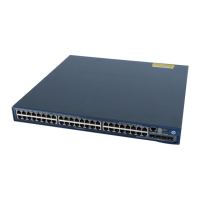11
To configure jumbo frame support on one
Ethernet interface, enter Ethernet interface
view.
To configure jumbo frame support on a
group of Ethernet interfaces, enter port
group view.
Enable the interface to accept
jumbo frames
Required
By default, an Ethernet interface accepts
jumbo frames (up to 9216 bytes).
Enabling single-port loopback detection on an Ethernet
interface
If an interface receives a packet that it sent, a loop occurs. Loops might cause broadcast storms,
degrading network performance. You can use loopback detection to detect loops on an interface and
configure the protective action to take on the interface when a loop is detected, for example, to shut
down the interface. In addition to the configured protective action, the switch also performs other actions
to alleviate the impact of the loop condition, as described in Table 1.
Table 1 Actions to take upon detection of a loop condition
No protective action is configured
A protective action is configured
Put the interface in controlled mode.
The interface discards all incoming
packets, but still forwards outgoing
traffic.
Create traps.
Delete all MAC address entries of
the interface.
Perform the configured protective
action.
Create traps and log messages.
Delete all MAC address entries of the
interface.
Hybrid or trunk
interface
Create traps.
If loopback detection control is
enabled, set the interface in
controlled mode. The interface
discards all incoming packets, but
still forwards outgoing packets.
Delete all MAC address entries of
the interface.
Create traps and log messages.
If loopback detection control is
enabled, take the configured
protective action on the interface.
Delete all MAC address entries of the
interface.
Follow these steps to configure single-port loopback detection:
Enable global loopback detection
loopback-detection enable
Required
Disabled by default.
Set the loopback detection
interval
loopback-detection interval-time
time
Optional
30 seconds by default.

